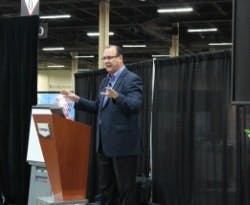Why are OEM certifications worth the effort for shops to achieve?
To ensure the next generation of vehicles are properly repaired, body shops must have the right tools, equipment and training. The leading automakers have a moral, ethical and possibly legal obligation to their vehicle buyers to ensure they can get their vehicle repaired correctly.
To do this, the OEM's need to establish a national network of certified shops so that no matter where a vehicle driver may travel, they will have a certified repair provider choice should they need one. The certification process is based upon real, bona fide qualifications and manufacturer-specified requirements that are necessary to properly repair the vehicle. Passenger safety and vehicle value demand this and nothing less.
The rewards for the shop are exponential because they get multiple OEMs under one streamlined, cost-effective and efficient program. Once they are officially certified, the shop will have the ability to set their shop apart and make a further distinction in their market. They are able to position their shop as the ultimate choice adding to their own marketing and sales efforts by using the optional marketing and promotional tools provided.
OEM referrals could become an even more valuable source for repair volume than DRPs are today. Shops that work with dealer referrals already understand the potential value of alternative sources of repair business.
What do shops need to do to get involved with OEM certification programs from a training, tooling and equipment perspective?
The biggest cost for the shop is training. The other costs for a shop are the required tools and equipment such as a three-phase, squeeze-type resistance spot welder that meets the OEM specifications. Shops must also consider the requirements for advanced materials such as aluminum if they elect to repair those vehicles. The cost for a clean room, welders and tools is significant. However, with the assurance that the vehicles will be referred to their shop once they are certified, the shop will gain a strong return on investment. Over time, it will more than pay for itself.
Regardless of anything else, it should be clearly understood that possessing the right tools, equipment, training and facilities is not an option. Shops just cannot repair future vehicles properly without them. If not, shops will have to limit their repair offerings to only older model vehicles and phase-out their business over the next decade.
In what ways do you see OEM certification programs influencing the future of the collision repair industry?
There are two parallel paths. One is to repair vehicles according to low-cost alternative methods at lower profit margins. The other option is to provide proper repairs according to OEM repair procedures using the required tools, equipment, training and facilities.
For the last 10–15 years, more and more repair volume is going through insurance-driven DRPs. Too often shops have been pressured into alternative repair practices that have reduced quality, safety and shop profits. The OEMs want shops to repair vehicles correctly according to their repair procedures using the right tools and equipment by properly trained technicians. Certainly, under this program the shop should never do anything that will lessen the fit, finish, durability, value or safety of the vehicle.
The potential impact is enormous. OEMs have a great deal of influence and credibility to new car buyers. Each year approximately 15 million new cars are sold by the top automakers. Over the next five years, that is 75 million vehicles and at least 30 million customers. I think any shop owner can do the math and see the potential impact to their business in the future.




